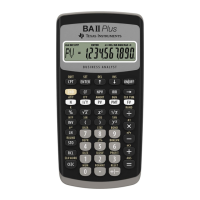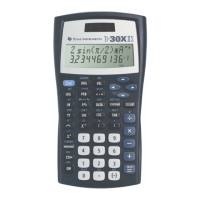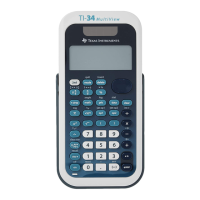TI-89 / TI-92 Plus / Voyage™ 200 PLT Statistics with List Editor App „ Plots Menu 36
Plot Setup
Description
„ (
Plots) Æ 1:Plot Setup
Use Plot Setup to define and manage plots.
Plot Setup Menu
From the
Plot Setup menu, you can access the commands by pressing the calculator
function keys ƒ (
Define), „ (Copy), … (Clear), † (Ÿ (Select)), and ‡ (ZoomData).
ƒ Define Lets you define a plot using applicable pl
ot types, plot symbols (marks),
lists, frequencies, and categories.
„ Copy Lets you copy a plot to another plot.
… Clear Lets you clear a plot.
† Ÿ (Select) Lets you select a plot for graphing and then toggle it on or off.
‡ ZoomData Lets you redefine the viewing window to display all statistical data
points and go to the graph automatically.
Defining a Plot Using ƒ Define
„ (Plots) Æ 1:Plot Setup Æ ƒ (Define)
In the Plot Setup dialog box, you select the plot type (Scatter, xyline, Box Plot, Histogram,
Modified Box Plot) and specify the options.
Plot Type Choose one of five plot types: Scatter, xyline, Box Plot, Histogram, Mod
Box Plot
. The type you choose affects the remaining options. Options
that are not applicable to a plot type are grayed out.
Mark Select the symbol used to plot the data points: Box (›), Cross (x), Plus
(+),
Square (0), or Dot (ø).
x Type or insert the list name (list1, list2, etc.) used for x values, the
independent variable.
y Type or insert the list name used for y values, the dependent variable.
This option is active only for
Plot Type = Scatter or xyline.
Hist. Bucket Width Specify the width of each bar in a histogram. For more information,
refer to the guidebook.
Use Freq and Categories? Select NO or YES. Freq, Category, and Include Categories are active
only when
Use Freq and Categories? = YES. Freq is active only for
Plot Type = Box Plot, Histogram, or Mod Box Plot.
Freq Type or insert the list name that contains a “weight” value for each
data point. If you do not enter a list, all data points are assumed to
have the same weight (1).
Category Type or insert the list name that contains a category value for each data
point.
Include Categories If you specify a Category list, you can use this field to limit the
calculation to specified category values. For example, if you specify
{
1,4}, the calculation uses only data points with a category value of 1 or
4.

